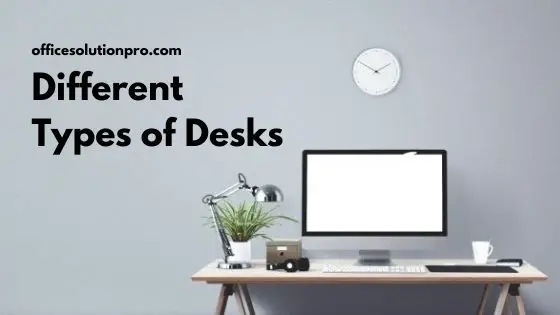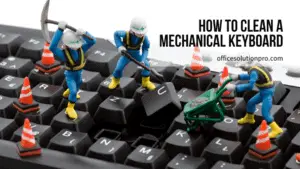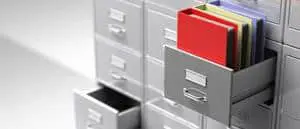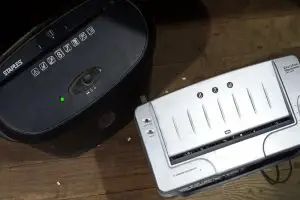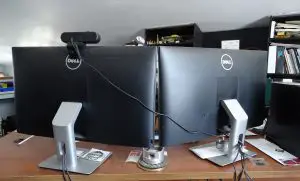Before you stumbled upon this article, we bet that you couldn’t name more than five desk types. How many ways can you possibly configure a hard workspace surface? It turns out that there are dozens of different types of desks, and we’ll explain the most popular 16.
Here are the different types of desk models:
Computer desk
Standing desk
Walking or treadmill desk
Adjustable desk
Writing desk or table
Executive desk
Secretary desk
Rolltop desk
Armoire desk
L-shaped and corner desk
Cubicle
Carrel desk
Dual-sided desk
Floating desk
Lap desk
Drafting table
Desks exist for every purpose, space, and style. More modern desks provide solutions to everyday problems in our 40-hour-a-week workday. Whatever your needs, there’s undoubtedly a desk to suit you.
Different Types of Desk Models:
1. Computer Desk
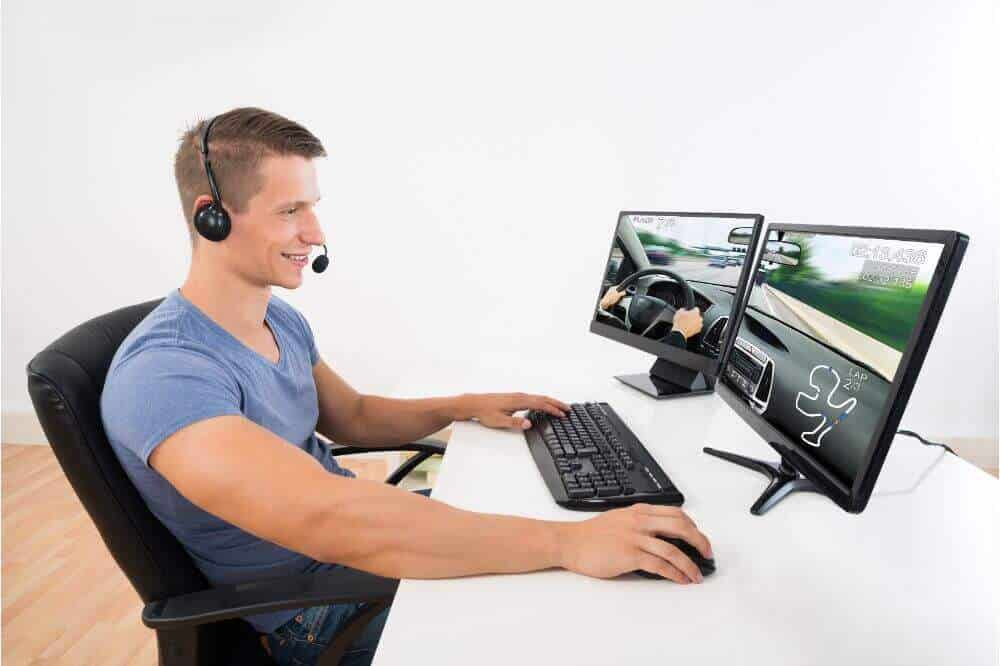
Computer desks offer a huge space for multiple monitors.
Computer desks are made specifically for computer users. They solve the problem of storing a desktop computer to give you the maximum amount of desktop space. Some also have shelves for printers or scanners as well. They are usually spacious to accommodate computer monitors, sometimes more than one.
Useful computer desk features include:
- A pull-out tray for your keyboard
- Under-desk storage for your CPU
- Under-desk drawers or shelves for storage
The downsides of a computer desk are:
- If you switch to using a laptop, the CPU storage space and keyboard tray become useless.
- They often don’t provide a lot of extra desktop workspace.
2. Standing Desk
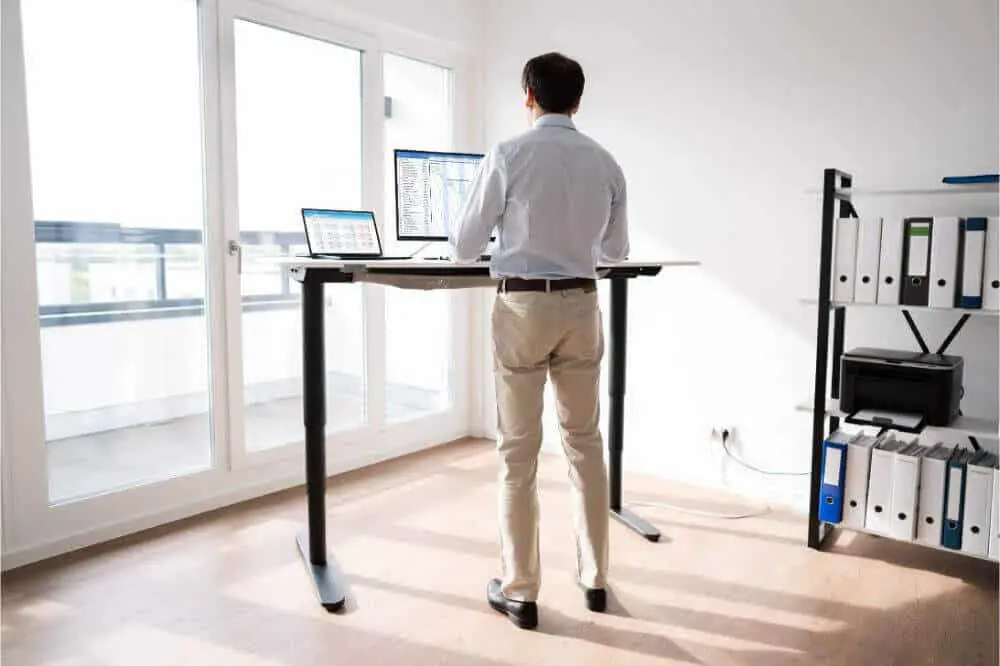
A standing desk is sometimes called a riser. They incorporate healthy standing instead of sitting.
In the past few years, standing desks have become more popular. These desks allow you to work while standing rather than spending your day in a chair. Because sitting all day is bad for you, these desks have a reputation for being healthier than desks that force you to sit for long hours.
Standing desks have several advantages:
- You burn more calories standing and moving around than you do sitting.
- People who are fidgety by nature get distracted less and get more work done.
However, standing desks do also have their disadvantages:
- If you do get tired of standing, you need a tall chair to accommodate the desk height.
- You will need a thick mat underneath to help relieve foot pain and joint stress.
3. Walking or Treadmill Desks
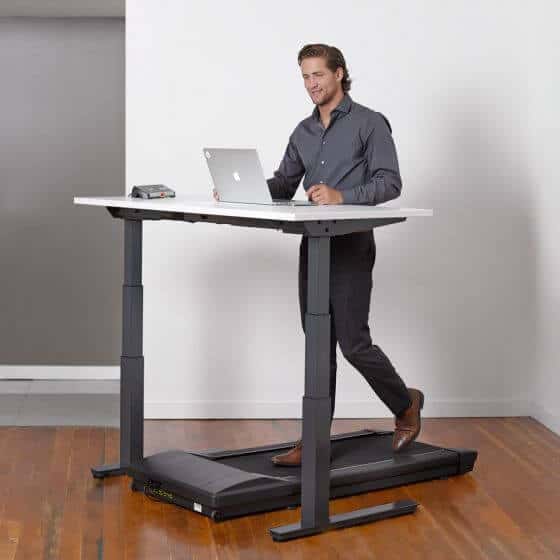
Treadmill desks take standing desks to a whole new level.
Walking desks or treadmill desks are a twist on the standing desk. They are standing desks with a built-in treadmill underneath. The controls are incorporated into the desk so that you can work and walk.
These desks provide significant benefits:
- You can stand and get exercise while you’re working.
- Built-in controls on the desktop aren’t as awkward as putting a regular treadmill under a standing desk.
But you might consider some of the negatives before deciding on one:
- Getting sweaty at the office isn’t going to be very attractive.
- If you want to stop walking, you either have to have a place to stow the treadmill portion or stand on the hard treadmill surface.
4. Adjustable Desk Converter
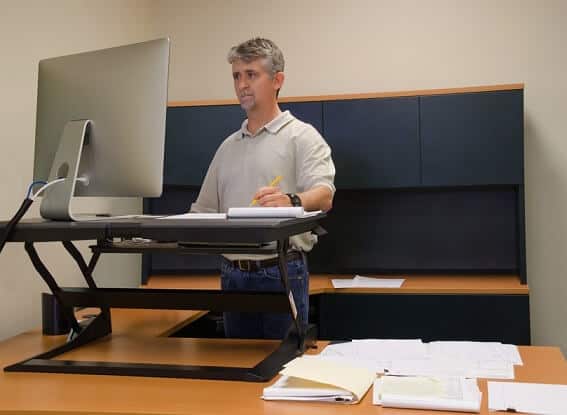
An adjustable desk is an excellent way to start standing while working. Just buy it and place it on top of your existing desk!
Adjustable desks try to solve some of the problems that standing desks have. You get the best of both worlds with a desk you can use for sitting and standing. Some versions move the entire desk up and down, while others only move the monitor up and down.
Adjustable desks solve several problems:
- They allow you to stand for more movement and will enable you to sit when you become tired.
- You don’t need a tall chair if you want to sit.
Unfortunately, some problems do exist:
- Computer cords may not be long enough and can become tangled or smashed.
- The mechanism for adjusting and locking the desk can be challenging to use.
- The desk can be too heavy or awkward to move up and down without help.
PRO TIP: If you’re interested in standing while working, why not consider trying a standing desk converter? These units are placed on top of your existing desk so you don’t have to renovate your workspace, and can be easily raised or lowered. Not only are they convenient, but they are more affordable than regular standing desks.
5. Writing Desk or Table
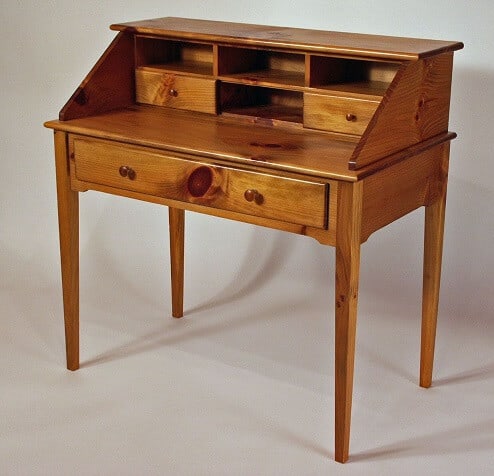
Writing desks are simple. They often come in an antique design.
A writing desk is one of the simplest desks you can find. The most basic versions are similar to a table with a working surface and space underneath for your legs. Some include shelves underneath or on the sides as well.
There are many reasons that the simplicity of a writing desk can be a great choice:
- They accommodate a variety of computer types and usage needs.
- They come in various depths and lengths depending on your surface space and needs.
However, there are some drawbacks:
- If they have any storage space at all, it’s usually shelves rather than drawers, which can look messier.
- They don’t hide cords at all, so they’re best for laptop work.
Related: Writing Desks vs. Computer Desks
6. Executive, Credenza, and Pedestal Desks
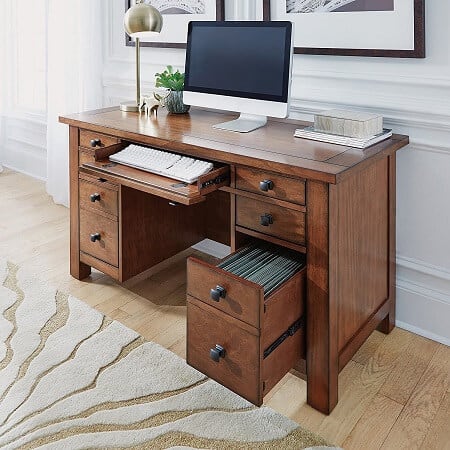
Executive or credenza desks often come with cabinets to store documents.
Executive desks and credenza desks have solid enclosing sides around their bottoms. Some include filing drawers as well. Pedestal desks are the same as executive and credenza desks, but they also include decorative short legs for added style.
Credenza desks are great for:
- Hiding cords behind their solid backs
- Hiding your legs and anything under your desk from clients
- Keeping paperwork and supplies organized and hidden in drawers
They aren’t perfect, though. You might not like some things:
- Your monitor or laptop will take up a lot of valuable real estate on top.
- There may be too little space below the desk to store your CPU so that you can avoid kicking it.
7. Secretary Desk

Secretary desks are small, yet functional.
Secretary desks are very simple! They are basically small desks with small desktop storage spaces to hold things like letters or books. They often include small drawers for storing small items like stamps or office supplies. Not only are they compact, but they provide a neat and tidy workspace as well.
You might find a secretary desk useful for:
- Small manual tasks like paying bills
- Keeping small office supplies organized
- Laptop work
However, you won’t want a secretary desk for:
- All-day work because it’s too small
- A desktop computer because there’s nowhere to put your CPU
- Comfort because some don’t even have space for your legs to move
8. Rolltop Desk
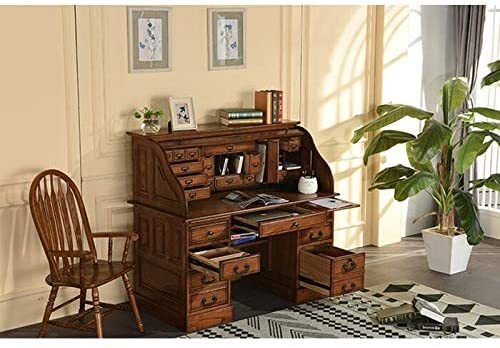
Rolltop desks combine the credenza or executive desk structure with the desktop storage space of a secretary desk. Many have a cover that can roll over your workspace for privacy and tidiness when it’s not in use. While all have a rounded top, not all include a cover.
You’ll like that this desk has:
- Lots of storage space to keep desktop items, office supplies, and files organized.
- A top that rolls over the desk (on some models) to keep your work private, cover your mess, or prevent dust
However, this desk is not for everyone:
- The desktop storage takes away valuable workspace for all but pen-and-paper or laptop work.
- There’s not any space under the desk or on the desktop for a CPU.
9. Armoire Desk


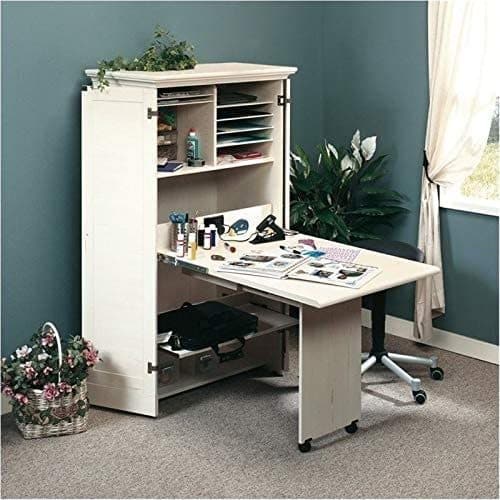
Armoire desks provide a desktop, shelves, and storage space for your CPU and printer. What makes the armoire desk unique is that it is inside a cabinet that can close from top to bottom when it’s not in use.
People like armoire desks because of these features:
- They have a variety of shelves and drawers for storage spaces.
- They can be closed up for privacy, neatness, and security when not in use.
- They save space and look like a piece of furniture rather than an office when not in use.
However, they aren’t perfect:
- They’re bulky, aren’t easy to move, and sometimes don’t hold up in multiple moves.
- They don’t have adequate space for your feet.
- They don’t provide a lot of desktop space.
10. L-Shaped and Corner Desks

Like their name, L-shaped desks are shaped like the letter “L.”
L-Shaped desks and corner desks come in a variety of styles. Some look more like writing desks with table legs, while others are fully-enclosed on the bottom like executive and credenza desks. Their shape comes from two connected working surfaces.
You’ll like an l-shaped or corner desk for these features:
- They provide expanded working space to accommodate files, papers, projects, a computer monitor, a CPU, a laptop, or anything you need on your desk.
- They offer two separate workspaces.
The only disadvantages of an l-shaped or corner desk are that:
- They take up more space than a regular desk.
- They’re harder to configure in every space.
- They’re a challenge to move.
11. Cubicle
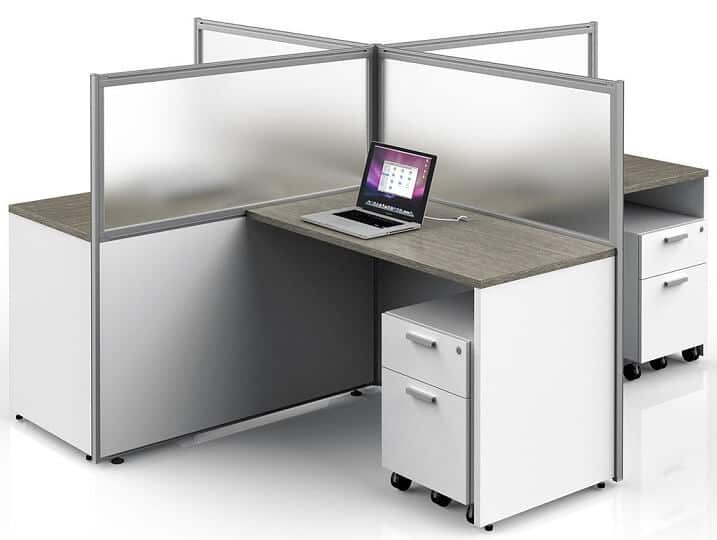
Cubicle desks combine all the elements of an l-shaped desk with a privacy screen on at least two sides. The screen allows multiple people to work in the same office or room with a semblance of visual and auditory privacy. You will often find these types of desks inside an office with multiple employees.
A cubicle has several advantages:
- A semi-private and personalizable workspace shields from others with a screen.
- Large versions can offer a sizable working space with an l-shaped desk.
- Storage space for work items
But it’s not a perfect multi-person-workspace solution because:
- Audio and visual privacy vary by design.
- Most are more utilitarian than aesthetic in design.
- They can feel claustrophobic.
12. Carrel Desk
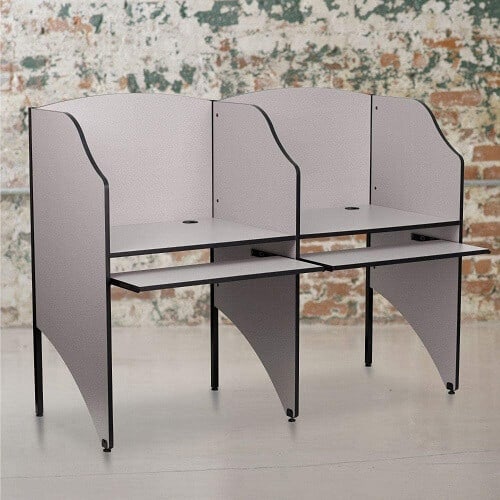
Carrel desks are designed for personal privacy.
Carrel desks are the most minimal cubicle desk options available. You’re most likely to see these in a library or classroom setting. They provide a minimal personal workspace with a surrounding shell on top of the desk for personal privacy.
These are great for:
- Privacy for working, studying, or testing with space for books, papers, or a laptop
- Providing a quieter and more private space in a room with lots of people or activity
Disadvantages include:
- They don’t usually have space for long-term storage.
- They don’t have a lot of desktop space.
- Their privacy is minimal.
13. Dual-Sided Desk
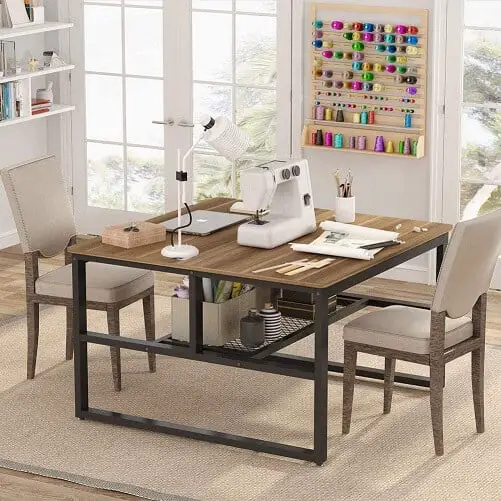
A Dual-sided desk is perfect for working partners who need to face each other while working.
Dual-sided desks are great solutions for giving two people workspaces in the same room. These extra-deep desks can keep computer screens private. Or they can be a standard work desk for you while providing your client space for spreading out and signing papers.
Things you’ll like about this desk:
- They come in a variety of styles, including writing desks and executive desks.
- Some include internal drawers, shelves, and filing storage.
- They give two people a shared space for working together with spatial privacy.
Things you might not like about this desk include:
- Most do not provide privacy screen partitions between workspaces.
- It can be challenging to separate workspaces, which can cause relational friction if the people sharing the desk have differing neatness standards.
14. Floating Desk
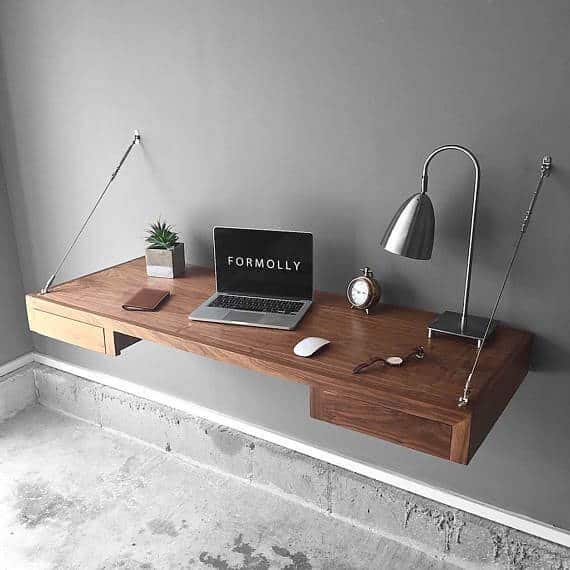
Floating desks are units placed on the wall. They function without legs.
Floating desks attach to the wall. Some are simply a long shelf for the workspace, while others include shelf space above or below the working area for storage. You usually face the wall, but some jut out like a table so that the wall is on one side of you instead.
Floating desks’ versatility allows them to :
- Save floor space in smaller rooms
- Double as a storage shelf when not in use as a workspace
- Accommodate more than one person if long enough and with extra chairs
There are some qualities you need to consider before committing to a floating desk:
- If they’re built-ins, they can affect your ability to sell your home if the next buyer doesn’t want a desk in that room.
- You can’t feed cords behind them if you have a desktop computer.
15. Lap Desk
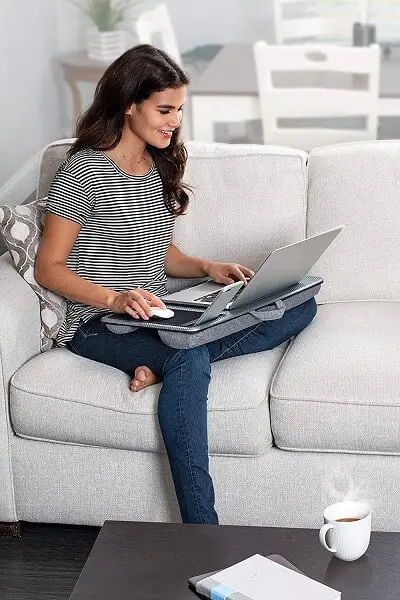
Use a Lap desk to allow you to work on sofas and chairs without the need for much space.
Lap desks allow you to place your work or laptop directly on your lap. They come in a variety of styles and sizes. Some are just a board, while others slant to be more ergonomic for typing, have space for a mouse, or include storage space.
Some features that might make a lap desk attractive are that:
- They Are Portable
- Don’t take up floor space
- Allow you to work from your favorite chair, couch, bed, or even your car
Lap desks do come with limitations:
- They provide minimal workspace.
- They offer minimal storage space, so you’ll need another place to keep office supplies or files.

16. Drafting Tables
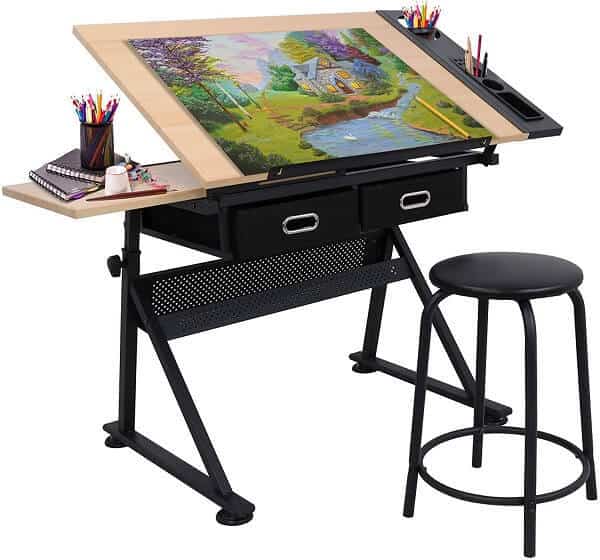
Unleash your creative side with a drafting table!
Drafting tables are the ideal workspace for people who draw or look at large sheets of paper during their workday. The desktop slants to become an angled working surface. Some also combine storage space for paper and supplies.
A drafting table provides these benefits:
- A work surface that you can adjust to the angle you need
- A ledge to prevent writing utensils from rolling off
- Ample space underneath to move your chair
The only real drawback of a drafting table is that:
- Most don’t come with an extra workspace for a computer, scanner, or other modern office equipment.
- The mechanisms for raising, lowering, and changing desk angles can be tricky to use.
Some Closing Words About Desks
And there you have it, the different types of desks explained. People around the world and across the years have developed different types of desks for their working needs. Some are multipurpose, while others are for specific tasks. Desks can accommodate one person or several people.
No matter your room size, storage needs, or aesthetic tastes, you can find a desk to fit your purposes. Choosing the right desk can make a world of difference in how you feel at the end of your workday.
